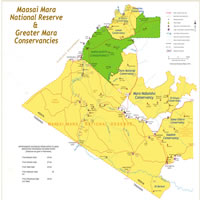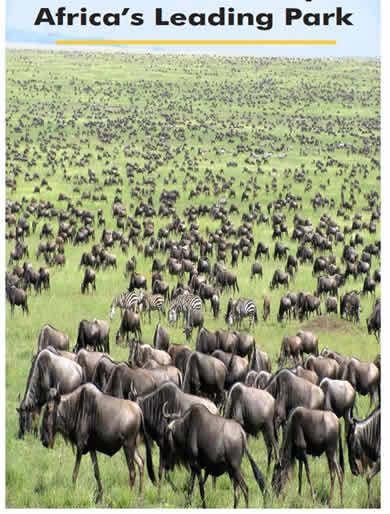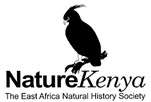Masai Mara National Reserve
Wildebeest River Crossing
Fact File: Masai Mara, Kenya
The mighty Masai Mara remains one of Kenya's best loved game reserve. 1,510 sq. kms/ 583 sq. miles of wide savannah, rolling hills and riverine forest with huge grazing herds, bountiful birdlife and Africa's largest mammal population and species after the Democratic Republic of Congo (according to The Mammal Diversity Database of the American Society of Mammalogists (ASM)). Kenya lion population is estimated recently to be over 2,500, the 4th largest in Africa and about 6.8% of in the entire world
What makes Masai Mara special in terms of command of wildlife experiences is the Wildlife density (Park Size divided by Population for 100Sq Km.) This simply tells how easily, quickly and frequency of spotting them. The table at 'Overview' below gives an example of lion distribution, population and density in Kenya's major parks.
Each year the Mara is the staging ground for the Great Migration, one of the most awe-inspiring natural events in the world.
Masai Mara National Reserve:
An Overview
The mighty Masai Mara remains one of Kenya's best loved game reserve. 1,510 sq. kms/ 583 sq. miles of wide savannah, rolling hills and riverine forest with huge grazing herds, bountiful birdlife and Africa's largest mammal population and species after the Democratic Republic of Congo (according to The Mammal Diversity Database of the American Society of Mammalogists (ASM)). Kenya lion population is estimated recently to be over 2,500, the 4th largest in Africa and about 6.8% of in the entire world
Wildlife Populations and Density: An Outlook
What makes Masai Mara special in terms of command of wildlife experiences is the Wildlife density (Park Size divided by Population for 100Sq Km.) This simply tells how easily, quickly and frequency of spotting them. The table at 'Overview' below gives an example of lion distribution, population and density in Kenya's major parks.
Park | No. of Lions | Park Size | Approx. Density |
Masai Mara National Reserve | 1,000 lions | 1,510 km² | 66.2 lions/100 km² |
Nairobi National Park | 50 lions | 117 km² | 42.7 lions/100 km² |
Samburu, Buffalo Springs & Shaba National Reserves | 180 lions | 549Km2 | 30.5lions/100Km2 |
Amboseli National Park | 100 lions | 392 km² | 25.5 lions/100 km² |
Tsavo West National Park | 200 lions | 9,065 km² | 2.2 lions/100 km² |
Tsavo East National Park | 250 lions | 13,747 km² | 1.8 lions/100 km² |
Masai Mara leads with approximately 66 lions per square kilometer as compared to the expansive and highly reputed Kruger National Park in South Africa (19,485 sq km / 7,523 sq miles) - About 2.5 lions per 100 sq km even if the lion population is close to 2,000. Certainly a better and intimate experience of sighting and exploring Masai Mara for one the big cats than anywhere else.
It is worth mentioning that Tanzania has the world's and Africa's largest population of lions estimated between 15,000-16,000. However, the distribution and density over a large acreage is only 1.5-1.6 lions per 100sq km. South Africa is second in Africa and the world with 3,500, but with the world's highest density at 3.0 followed certainly by Kenya (and its iconic Masai Mara) with 2,500 with an index of 1.2.
So Where would you choose for a Top Wild Cats Safari: King Lion Enthusiasts? Masai Mara, certainly! It exceeds Kruger's density and distribution parameters.
The Great Migration in Masai Mara & The Greater Mara Conservancies: A Natural Theatre in The Wild
Each year the Mara is the staging ground for the Great Migration, one of the most awe-inspiring natural events in the world.
The Greater Mara complements Masai Mara National Reserve and it is usually considered a part of it in computing Masai Mara acreage. The Greater Mara is most reputed for success in sustainable tourism practices through environmental and wildlife conservation benchmarks, exclusive wildlife exploration and superior accommodation.
In order of their sizes and acreage, they are Mara North, Pardamat Conservation Area, Oloisukut, Mara Naboisho, Olare Motorogi, Mara Siana, Mara Ripoi, Ol Kinyei, Mara Lemek, Ol Choro Oirouwa, Maasai Moran, Nashulai Maasai, Mbokishi Mara, Mount Suswa, Olderkesi, Isaaten, Orpua, Nyekweri Oloirien, Olerai, Enonkishu, Nyekweri Kimintet and Enarau Conservancies.
Mara Safari Planning: Accommodation, Budget & Masai - Getting The Best Bargain
Choice of Masai Mara accommodation standard is the key determinant in a holiday budget and Masai Mara has a wide range of best value (decent) facilities to world class standards from as low as $250 (e.g. Mara Sarova Game Camp) per person per night to $1,800 (Mara Plains Camp).
We as your safari advisors, consultants and guide, do approach safari planning using a thorough model by:
- Listening to our holiday planners and understanding the Masai Mara Safari experience they seek
- Make offers and suggestons for a bespoke Masai Mara Safari for client consideration
- Discuss together and finalize on accommodation options, travel modes (Domestic inter-destination flights, 4x4 road safari, budget safari-minivan option, transfers by SGR Train - Nairobi to Mombasa, airport / airstrip transfers, special helicopter transfers), and suggested must-do activities in Masai Mara like the Hot Air Balloon Safari (skies over Mara) and visit to Maasa Cultural Village, Special treats for special people etc
- Provide full documentation of the Masai Mara Safari including flyers, fact sheets, hotel reviews and a tentative invoice
- Discuss cancellation and Masai Mara safari re-scheduling, terms and conditions for final approval.
- Receive required payments (deposits) to guarantee safari and issue receipt for the safari to Masai Mara
- Confirm to client on accommodation reservations through issuance of Booking Confirmation Vouchers and hotel/lodge/camp contact information
Conclusion
A holiday in Kenya without a safari to Masai Mara is missing the best of Africa whether travelling as couple, family, group or business vacation.
The Mara Safari Experience
Wildebeest Migration happens across the parks of Masai Mara, Kenya and Serengeti, Tanzania throughout the year. The timing and directions are rarely exact although the similarities year after year makes the phenomenon a real natural wonder.
The typical routes undertaken are:-
Wildebeest Migration in Serengeti National Park, Tanzania
January, February & March
- The migration animals are in Ndutu area of Southern Serengeti in Tanzania.
- By the end of March the wild party spread over the short grass plains in Southern Serengeti, Loliondo and Ngorongoro Conservation Area
April
- The great migration herds move north, through Moru Kopjes and Seronera areas of Central Serengeti
May to June
- The migration herds head north through Seronera towards the Western Corridor to cross the Grumeti River. This is the first annual crossing. Crocodiles have a feasting season and the predators have their sensational hunts.
- The great migration herds pass through Ikorongo and into the far north-west of the national park
Movement into Masai Mara, Kenya
July, August, September & Mid October
- By mid July, the herds cross the Sand River into Masai Mara National Reserve.
- There are traditional routes here where the herds head northwest into the Mara Triangle before crossing the Mara River. During these months, splits may be noted, with some crossing into Mara North Conservancy, others wandering to Talek areas and crossing to join the Loita herds in Olare Motorogi, Naboisho and Siana-Olarro Convervancies
Mid October - December
The herds move south again from Masai Mara into the eastern side of Serengeti through Loliondo Game Protected Area, wandering into NCA and heading to South Serengeti
Migration in Orbit
November, December & January, Serengeti Wildebeest Migration in Tanzania
Onset of short rains. Short grass sprouts. Zebras are particularly fond of short sweet grass. Most enjoyable feeding time as grass is most nutritious.
February
- Calving season.
March
- The herds are with young ones. Each follows the mother wildebeest.
April - June
- Beginning of the rutting season. Lasts until June
- Wildebeest have begin their migration north into Moru Kopjes, then west of Seronera
- Headed to Grumeti river for the first crossing of the year
- Grumeti River is a series of pools and channels, not continuous fast flow like the Mara River
- Feast for Crocos, though not as spectactular as the crossings of the Mara River in Masai Mara, Kenya
July to October
- First crossing at Sand River
- Series of crossing near the Lookout Hill
- Series of crossing into the Paradise plains
- Movement across to Greater Mara
- Joining and interlop of Loita Plains herds










